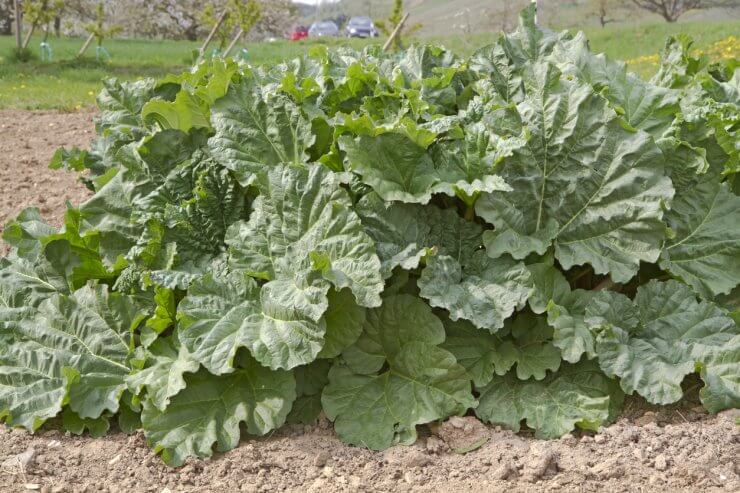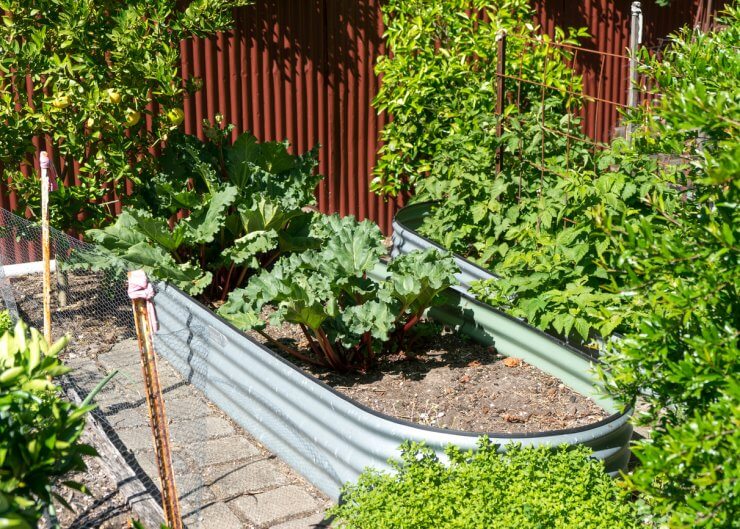
Rhubarb growing in the ground
Planting
Rhubarb is a cold-hardy perennial, and it likes to have some space to spread out—like 4 feet across. Your best planting strategy is to find a spot along the edge of the garden where your rhubarb can settle in for the long haul—and by that, we mean decades. Healthy plants can be productive for 10, 20, even 100 years! So pick your planting spot with care.
The easiest way to plant rhubarb is to plant what are called starts, sets, splits, or crowns; these are usually a piece of an existing rhubarb plant that’s been divided or a bare root plant from a nursery. Ideally, you should plant your crowns or bare roots in the spring, as soon as the soil can be worked; this may be four to six weeks before your average last frost date. This will give the new plants the time they need to build up reserves for their first winter in your garden. Crowns can also be planted in the fall, before the first frost, as long as they’re planted in fertile soil and you give them some TLC over the winter.
For crowns, dig a hole 18 inches deep and 3 feet wide. Put a handful of bone meal in the planting hole and then fill it nearly to the top with aged compost and aged manure, or a good planting mix.
Pack the soil in and set your crown an inch or two deep in the soil. Make sure the growing tip is angled toward the surface of the soil.
You can plant rhubarb from seed, but you’ll want to acquire seed from a reputable source, not your neighbor’s rhubarb. Unless you get seed from a seed company, your rhubarb seeds will not grow true.
The other challenge with growing from seed is the long wait before you can harvest. See Growing Rhubarb from Seeds or Crowns/Splits/Sets/Divisions for details on the growing-from-seed process.
Keep the soil evenly moist, but not soggy, as your plants are settling into their new home.
Plant Spacing
Rhubarb needs lots of space to stretch its marvelous green leaves, the solar panels for the plant. Give each plant its own 4-by-4 foot plot, with 4 feet between rows (if you’re planting that many plants).
One of the nice things about this spacing is that rhubarb tends to shade out weeds—assuming that you planted it in weed-free soil to start with.
Keep this spacing in mind as you plan your planting. These plants are going to be with you for a long time.
Companion Planting
Since rhubarb is a perennial, consider planting some other perennials along with it. Artichokes and asparagus are good choices for a perennial garden; perennial vegetables can flourish and produce for 10 years or more.
You can also plant crops from the cabbage family near rhubarb, such as Brussels sprouts, cabbage, or kale. But be sure you don’t accidentally harvest rhubarb leaves when you mean to harvest kale; remember that rhubarb leaves are toxic to humans and pets. Also, avoid planting root crops near rhubarb; they can interfere with the rhubarb plant’s root system.
Raised Beds

Rhubarb growing in raised bed
A raised garden bed or planter is an excellent option for growing rhubarb if you don’t have soil that’s ideal for rhubarb (heavy clay soil, for example). Raised beds also help with drainage, which is essential for healthy rhubarb plants. You can even buy raised beds or build one yourself to fit your space. Planters should have holes in the bottom of the container and a drip tray underneath to guard against overwatering.
Watering and weeding will be easier if you have your rhubarb in a raised bed or planter, although weeding shouldn’t be much of an issue with rhubarb’s huge, shading leaves. Raised beds are a good alternative to growing in open land. And if you fill a raised bed with packaged garden soil, you know you’re providing a cleaner and healthier environment for your plants from the outset.
Packaged garden soil means less weeding than you’d have from digging a hole in the ground; and with a raised bed or container, there’s less bending down to do your weeding!
How do you plant your rhubarb? What criteria for site selection has worked for you? Do you use your rhubarb as companion plants? Please share your ideas with us.


 Previous
Previous


A little confused. The article says to give each plant a 4×4 plot, but the photo used that is definitely not 4×4. That looks like a 2×6 or 2×8?
thank you for your help. You are a great resorce!
Am I understanding that heavy, clay soil is perfect medium for growing Rhubarb? If so, then I shall be in Rhubarb Heaven!
Heavy, clay soil? Am I understanding correctly that it is the right soil for rhubarb? If so,I shallbe in Rhubarb Heaven!!!